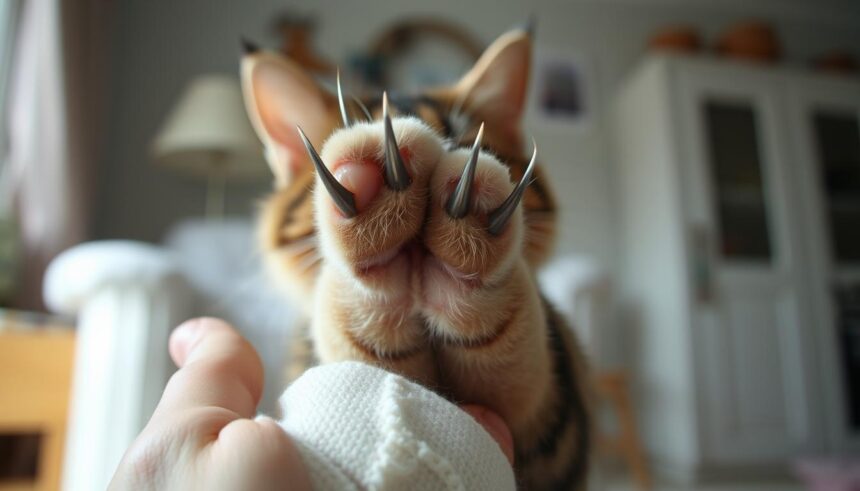Cat bites can be a serious concern, especially for those with weakened immune systems. These bites can lead to infections due to bacteria in a cat’s mouth. It’s important to understand the risks to prevent them.
Cat bites can cause serious infections within 24 to 48 hours if not treated. Knowing the dangers of cat bites is key to staying safe.
The risk of infection from cat bites varies, from 20% to 80%. This shows how crucial it is to address these bites. Getting medical help quickly can prevent serious problems, like septicemia.
It’s advised to wash the wound under running water for at least 5 minutes after a cat bite. This helps lower the risk of infection.
Key Takeaways
- Cat bites can lead to serious infections within 24 to 48 hours if left untreated.
- The potential risks of cat bites include infections caused by bacteria like Pasteurella multocida.
- Vulnerable populations, including children and the elderly, are at heightened risk for severe infections.
- Prompt medical treatment can reduce the risk of serious complications.
- Understanding the health implications of cat bites is crucial to taking proper precautions and preventing them.
- Recognizing the signs of infection, such as redness, swelling, and pain, is essential for timely medical attention.
Understanding Cat Bites
Cat bites can be serious. It’s important to know why they happen. Cats may bite out of fear, pain, or to protect their territory. Spotting when a cat is upset can help avoid bites.
Preventing cat bites is key because they can cause infections. The Centers for Disease Control and Prevention (CDC) says over 150,000 cat bites are treated each year in the U.S.
For cat bite first aid, cleaning the wound right away is vital. Not doing so can lead to worse problems. Knowing when to get medical help for cat bites is also crucial. Quick action can stop serious infections from happening.
- Cat bites can lead to serious infections, with signs of infection appearing as quickly as within 24 hours post-bite.
- Infections from cat bites can lead to conditions such as cellulitis and septicemia if left untreated.
- Approximately 30% to 50% of cat bites may get infected due to the bacteria present in cats’ mouths, particularly Pasteurella multocida.
By understanding why cat bites happen and taking steps to prevent them, we can lower the risk of infection. This ensures a safe and healthy bond with our feline companions.
| Cat Bite Infection Risk | Description |
|---|---|
| 30% to 50% | Risk of infection due to bacteria present in cats’ mouths |
| 24 hours | Timeframe for signs of infection to appear |
The Anatomy of a Cat Bite
Cat bites can be dangerous. Knowing how they work is key to treating them right. A cat’s teeth are sharp and can cause deep wounds. This makes them more likely to get infected.
Every year, over 400,000 cat bites are reported in the U.S. Many more cases might not be reported. The bacteria in a cat’s saliva, like Pasteurella multocida, can lead to infections. This is why treatment for cat bite infections is so important.
Proper cat bite wound care is crucial to stop infections. This means getting the wound checked, cleaned, and possibly treated with antibiotics. Sometimes, you might need surgery or debridement. If you feel a lot of pain or swelling within 48 hours, see a doctor.
Some important facts about cat bites are:
* About 20–80% of cat bites and scratches get infected
* Women are more likely to get bitten by cats than men
* People over 75 are more at risk of getting bitten
* Those with weakened immune systems are more likely to get infections from cat bites
By knowing about cat bites and taking the right steps, you can lower the chance of infection. Always focus on cat bite wound care and get medical help if you notice any signs of infection.
Potential Risks Associated with Cat Bites
Cat bites can cause infections, allergic reactions, and even diseases like rabies. They are a common cause of animal bite injuries worldwide. Cat bites are more likely to get infected than dog bites.
To avoid cat bite complications, preventing bites is key. Here are some risks:
- Infection risks: Cat bites can lead to bacterial infections, including those related to Bartonella, Brucella, Leptospira, and Campylobacter species.
- Allergic reactions: Some people may be allergic to cat saliva, which can cause an allergic reaction after a bite.
- Rabies and other diseases: Although rare, cat bites can transmit rabies and other diseases.
It’s important to be careful around cats to prevent cat bites. Knowing the risks helps protect you. If you get bitten, seek medical help right away.
Symptoms of Cat Bite Infections
Cat bites can be dangerous, and it’s key to know the signs of infection. Potential risks of cat bites include passing on bacteria, viruses, and other pathogens. Studies show that about 50% of cat bites in kids lead to infection.
Early signs of infection include redness, swelling, and warmth at the bite site. Sometimes, symptoms show up days or weeks later. If you notice any severe symptoms, it’s vital to see a doctor right away.
- Pus or fluid emerging from the wound
- Red or discolored streaks
- Swollen lymph nodes
- Fever, chills, or night sweats
People with weakened immune systems face a higher risk of serious infections from cat bites. If bitten by a cat, watch your symptoms closely. Seek medical help if you notice anything unusual or severe. Remember, are cat bites dangerous? Yes, they can be, but quick medical care can prevent serious issues.
| Symptom | Description |
|---|---|
| Redness and swelling | Common early signs of infection |
| Pus or fluid | May emerge from the wound, indicating infection |
| Fever and chills | May occur, especially in severe cases |
First Aid for Cat Bites
Act fast when you get a cat bite to avoid infection and help it heal. First, wash the bite with soap and water. Then, put on antibiotic ointment and cover it with a bandage.
Knowing when to get medical help is key. If the bite is deep, bleeds a lot, or won’t stop after 10-15 minutes, see a doctor. Also, if it gets red, swollen, or hurts, or if you’re immune-compromised, get help right away.
Immediate Steps to Take
- Stop the bleeding by applying pressure to the wound
- Wash the wound with soap and water
- Apply antibiotic ointment to the wound
- Cover the wound with a sterile bandage
When to Seek Medical Attention
See a doctor within 24 hours if the bite breaks the skin. This is crucial for people with weak immune systems, as they’re more at risk of infection.
Proper Wound Cleaning Techniques
Cleaning the wound right is key to avoiding infection. Wash it with soap and water for 3-5 minutes, then apply antibiotic ointment. Keep it covered with a bandage to prevent more irritation.
| Symptom | Description |
|---|---|
| Redness and swelling | Signs of infection, seek medical attention immediately |
| Bleeding that won’t stop | Apply pressure, seek medical attention if bleeding continues |
| Pain or tenderness | May be a sign of infection, seek medical attention if severe |
The Importance of Timely Treatment
Getting a cat bite treated quickly is key to avoiding problems and helping it heal. Every year, about 4 million Americans get bitten by animals, and many of these are cat bites. Cat bite wound care is vital to stop infections, which can happen in up to 50% of bites.
Not treating cat bites can lead to serious issues, like infections. These can cause lasting harm and disabilities. Treatment for cat bite infections usually means antibiotics and taking care of the wound. If you notice signs of infection like redness or swelling, see a doctor right away.
Cat bites can sometimes cause bigger problems, like rabies. It’s important to be careful around cats, especially if you don’t know if they’re vaccinated. Getting help fast and following medical advice can help avoid serious issues and ensure healing.
Here are some important steps for treating a cat bite:
- Wash the wound with soap and water
- Put antibiotic ointment on it
- Use a bandage to cover the wound
- Watch for signs of infection
By following these steps and getting medical help when needed, you can make sure the wound heals right. Remember, quick action is crucial to avoid long-term damage and help the wound heal.
Vaccination and Preventative Care
Vaccination is key in stopping cat bite problems. Keeping your cat’s vaccinations current lowers disease risk. Regular vet visits catch health issues early, stopping disease spread.
Preventing cat bites is also vital. Proper training and socialization of your cat help. Knowing cat behavior and signs of stress can prevent bites.
- Rabies vaccine
- Feline calicivirus vaccine
- Feline infectious peritonitis vaccine
These vaccines protect your cat from serious diseases. They lower the chance of cat bite problems.
Focus on vaccination and care to keep your cat healthy. Regular vet visits and training prevent bites. This ensures a safe, healthy bond with your cat.
| Vaccine | Description |
|---|---|
| Rabies vaccine | Protects against the rabies virus |
| Feline calicivirus vaccine | Protects against feline calicivirus |
| Feline infectious peritonitis vaccine | Protects against feline infectious peritonitis |
Tips for Cat Bite Prevention
Preventing cat bites means understanding how cats act and taking steps to lower their aggression. By spotting signs like a swishing tail or ears back, you can act fast. Cat bite first aid is key, but avoiding bites is even better.
Knowing how cats behave is crucial to avoid bites. Each cat shows discomfort or stress in its own way, like ears back or a thumping tail. By respecting their space, you can lower the chance of being bitten. Preventing cat bites needs patience, attention, and a desire to learn about cats.
To lower cat aggression, give them fun ways to play and exercise. This includes toys, scratching posts, and climbing spots. Keeping your cat active helps prevent boredom and frustration, which can cause aggression. Also, teaching them basic commands like “sit” and “stay” builds trust and respect.
By following these tips and watching your cat’s behavior, you can lower the risk of preventing cat bites. This makes your home safer and more peaceful for you and your pet. Remember, cat bite first aid is there if you need it, but preventing bites is the best approach.
When to Consult a Veterinarian
Regular health check-ups are key to avoiding cat bite complications and infection risks. Knowing when to seek veterinary care helps cat owners keep their pets healthy. This proactive approach ensures the well-being of both pets and owners.
If a cat shows signs of distress or aggression, it’s time to see a vet. Look out for hissing, growling, or swatting. These behaviors might signal health or behavioral issues. Early intervention can prevent cat bites and make a safer home for everyone.
When visiting the vet, consider your cat’s vaccination history, health, and behavior. A vet can help create a plan to prevent cat bites. This might include training, socialization, and keeping vaccinations current.
Myths About Cat Bites
Many people think cat bites are not serious. But, are cat bites dangerous? Yes, they can cause severe infections. Dr. Sam Campbell, with 27 years of experience, says only 2 or 3 people have died from cat bite infections. But, this doesn’t mean cat bites are harmless.
Some people believe cat bites are not serious and infections are rare. But, nearly three-quarters of cat bite infections are caused by Pasteurella multocida. Staphylococcus aureus can cause severe organ damage if not treated. The risk of rabies from cat bites is also six times higher than from dog bites.
Common Misconceptions
- Cat bites are not serious: This is a common myth, but cat bites can lead to severe infections and even rabies.
- Infections from cat bites are rare: In reality, nearly three-quarters of cat bite infections are caused by Pasteurella multocida.
- Cat bites are not contagious: This is not true, as cat bites can transmit diseases such as rabies and cat scratch disease.
It’s important to know the risks of cat bites and take precautions. If bitten by a cat, seek medical help right away. Look for signs like swelling, redness, or pain.
Facts vs. Fiction
In conclusion, cat bites are not to be taken lightly. They can be dangerous and even deadly. It’s crucial to understand the risks and take steps to avoid them.
| Cause of Infection | Percentage of Cases |
|---|---|
| Pasteurella multocida | 75% |
| Staphylococcus aureus | 10% |
| Bartonella henselae | 5% |
Legal Considerations for Cat Bites
When dealing with cat bites, it’s important to know the legal side. Preventing cat bites is key to avoid health problems and lawsuits. Cat bites are a big deal, making up 5% to 10% of animal bites. Almost all cat bites happen because of provocation.
In the U.S., dog bites are a big issue, costing $53.9 million a year in hospital bills. But cat bites are also risky, especially because of the bacteria in a cat’s mouth. This can cause deep wounds and infections. Knowing the legal side of cat bites is crucial for cat owners and those who interact with them.
Some important things to remember include:
* Reporting animal bites to the right authorities
* Getting medical help fast to avoid cat bite complications
* Making sure cats are vaccinated and well cared for to lower bite risk
* Knowing local laws about animal bites and who is responsible
By following these steps and understanding the legal side of cat bites, we can prevent problems. This helps keep both humans and animals safe and healthy.
| Animal Bite Statistics | Percentage/Number |
|---|---|
| Cat bites as a percentage of all animal bites | 5-10% |
| Dog bites as a percentage of all animal bites | 85-90% |
| Estimated annual inpatient costs from dog bites | $53.9 million |
Seeking Professional Help After a Bite
After a cat bite, getting professional help is key to avoid complications and aid in healing. Cat bite wound care is vital to prevent infections. Cat bites often lead to infections, with nearly 90% showing signs within 48 hours.
For the right treatment for cat bite infections, finding the right medical care is crucial. A healthcare professional can check the wound and guide you on how to care for it. They might prescribe antibiotics to prevent infection. Watch the wound for signs of infection like redness, swelling, or increased pain.
Some important steps for cat bite wound care include:
- Keeping the wound clean and dry
- Applying antibiotic ointment to the affected area
- Covering the wound with a bandage to protect it from further irritation
Also, counseling for anxiety from cat bites might be needed. It helps people deal with the emotional trauma of a cat bite. By getting professional help, you ensure you get the right treatment and support to heal from a cat bite.
| Complication | Symptoms |
|---|---|
| Infection | Redness, swelling, increased pain |
| Rabies | Flu-like symptoms, fever, agitation |
| Sepsis | Fever, chills, rapid heart rate |
Conclusion: Staying Safe Around Cats
To stay safe around cats, we need to know the risks of cat bites. We must also take steps to avoid them. As pet owners, we should care for our cats and ourselves.
Final Thoughts on Cat Bite Safety
Most cat bites are not dangerous if we take the right precautions. We should watch for signs of stress in cats and respect their space. If a bite happens, getting medical help quickly is key to avoiding serious problems.
Importance of Responsible Pet Ownership
Being a responsible pet owner is key to a good relationship with cats. This means getting them vet care, training them, and watching them, especially with kids. By focusing on health and safety, we create a better place for everyone.
































































